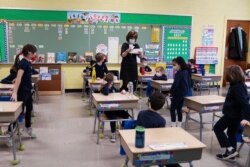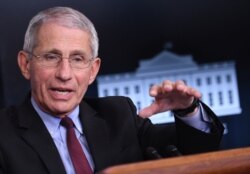The United States is struggling to reopen its public schools across the country amid the coronavirus pandemic, but the White House said Sunday it is hoping to have full-time, in-class instruction in a majority of schools by April.
“That's our goal, that's our objective, that's our plan,” White House press secretary Jen Psaki told ABC’s “This Week” show.
But she said meeting the goal is contingent on congressional approval of President Joe Biden’s $1.9 trillion coronavirus relief bill, which includes $130 billion in assistance for schools.
“Many schools across the country don’t have the resources to be able to invest in improving the facilities, on hiring more bus drivers, on hiring more temporary teachers so we can have smaller class sizes,” she said.
The U.S. Centers for Disease Control and Prevention has given “clear, science-based guidelines for school districts on the range of steps they can take to be safe. But every school in the country does not have that funding and the resources,” Psaki said. “We need the federal government to address that.”
The House of Representatives is planning to vote this week on the Biden relief package with the hope of full congressional approval by mid-March.
Currently, 47% of U.S. pupils in kindergarten through 8th grade are attending classes in person and 33% of 9th through 12th graders, while the remainder are attending classes virtually from home or in a mix of at-home and in-school instruction.
But one Republican critic of the size of the Biden relief aid, Congressman Steve Scalise of Louisiana, told ABC, “There’s money out there already,” more than $1 trillion in unspent funds from previous relief packages he says that could be sent to local communities throughout the country to help reopen schools. He also criticized the Biden package for not requiring schools to reopen in full if more money is approved.
“There’s so much science out there that says [virtual learning] is hurting kids,” Scalise said. “Millions of kids in America right now are not getting in-classroom learning every day.”
He said about 40% are attending classes in schools, “so you don’t have to reinvent the wheel. Those are in hot spots, places where the virus is not as serious. If you look at what the priority should be, it should be the children.”
“Our kids can’t wait,” he said. “They need to be in a classroom today. The science says they can be in a classroom today. The question is, is the will there for some politicians in Washington who are bowing to the teachers’ unions,” some of which are opposed to restarting full-time classroom instruction.
Dr. Anthony Fauci, the top U.S. infectious disease expert and Biden’s chief medical adviser, told CNN the “default position (of the Biden administration) is to get the children back to school and protect the teachers.”
He said school systems across the U.S. can reopen if they follow guidelines issued last week by the CDC to “get the children back to school in the safest way possible.”
The U.S., with 4% of the world’s population, is nearing 500,000 deaths, 20% of the global total, according to the Johns Hopkins University, which is monitoring the global outbreak.
“It’s terrible,” Fauci said. “It’s really horrible. It’s a terrible milestone in the history of this country.”
But Fauci said better days are ahead as millions of Americans are being vaccinated against the virus.
“We’re going to have a significant degree of normality toward the end of the year,” he said. “It’ll be much better over where we are right now.”











